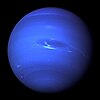Lista obiektów astronomicznych mających pierścienie
Lista obiektów astronomicznych posiadających pierścienie – lista przedstawiająca odkryte ciała niebieskie, które mają lub prawdopodobnie mają pierścienie wokół siebie.
Dotychczas odkryto siedem obiektów posiadających pierścienie, ponadto istnieją przypuszczenia o posiadaniu pierścieni przez dwa obiekty[a].
Lista
| Nazwa obiektu | Zdjęcie | Typ obiektu | Liczba pierścieni | Data odkrycia pierścieni | Artykuł w Wikipedii na temat pierścieni |
|---|---|---|---|---|---|
| Jowisz |  | planeta | 4 | 1979 | Pierścienie Jowisza |
| Saturn | planeta | 9 | 1658 | Pierścienie Saturna | |
| Uran |  | planeta | 13 | 10 marca 1977 | Pierścienie Urana |
| Neptun |  | planeta | 6 | 22 lipca 1984 | Pierścienie Neptuna |
| Chariklo[1] |  | planetoida | 2 | 3 czerwca 2013 | Pierścienie Chariklo |
| Haumea[2] |  | planeta karłowata | 1 | 21 stycznia 2017 | Pierścienie Haumei |
| 1SWASP J140747.93-394542.6b[3] |  | egzoplaneta | 30 | 2012 | Pierścienie 1SWASP J140747.93-394542.6b |
| Rea[4] |  | księżyc | ? | Hipoteza | Pierścienie Rei |
| Chiron[5] |  | centaur | ? | Hipoteza | Pierścienie Chriona |
Zobacz też
Uwagi
- ↑ Stan na 21 stycznia 2019
Przypisy
- ↑ F. Braga-Ribas et al.. A ring system detected around the Centaur (10199) Chariklo. „Nature”, 2014-03-26. DOI: 10.1038/nature13155. (ang.).
- ↑ J. L. Ortiz, P. Santos-Sanz, R. Iglesias-Marzoa. The size, shape, density and ring of the dwarf planet Haumea from a stellar occultation. „Nature”. 550, s. 219–223, 2017-10-12. DOI: 10.1038/nature24051. (ang.).
- ↑ Eric E. Mamajek et al.. Planetary Construction Zones in Occultation: Discovery of an Extrasolar Ring System Transiting a Young Sun-like Star and Future Prospects for Detecting Eclipses by Circumsecondary and Circumplanetary Disks. „The Astrophysical Journal”. 143 (3), s. 72, 2012-02-10. DOI: 10.1088/0004-6256/143/3/72. (ang.).
- ↑ NASA – Saturn's Moon Rhea Also May Have Rings (ang.)
- ↑ J.L. Ortiz, R. Duffard, N. Pinilla-Alonso, A. Alvarez-Candal i inni. Possible ring material around centaur (2060) Chiron. „Astronomy & Astrophysics”. 576, s. A18, 2015. DOI: 10.1051/0004-6361/201424461. arXiv:1501.05911. Bibcode: 2015A&A...576A..18O.
Media użyte na tej stronie
This full-disc image of Jupiter was taken on 21 April 2014 with Hubble's Wide Field Camera 3 (WFC3).
Autor: Tiouraren, Licencja: CC BY-SA 4.0
J1407b transit seen from its hypothetical exomoon in Celestia.
Original ring texture by ParticleGrasp.
This captivating natural color view of the planet Saturn was created from images collected shortly after Cassini began its extended Equinox Mission in July 2008. (Saturn actually reached equinox on August 11, 2009.)
This is an image of the planet Uranus taken by the spacecraft Voyager 2 in 1986. See File:Uranus.jpg for how Uranus would look to humans in visible light.
Autor: Celestia Team, Licencja: GPL
Centaur/comet/asteroid/dwarf planet candidate 2060 Chiron with rings as rendered in Celestia.
This picture of Neptune was produced from the last whole planet images taken through the green and orange filters on the Voyager 2 narrow angle camera. The images were taken at a range of 4.4 million miles from the planet, 4 days and 20 hours before closest approach in August 1989.The picture shows the Great Dark Spot and its companion bright smudge; on the west limb the fast moving bright feature called Scooter and the little dark spot are visible. These clouds were seen to persist for as long as Voyager's cameras could resolve them. North of these, a bright cloud band similar to the south polar streak may be seen.
Autor: ESO/L. Calçada/M. Kornmesser/Nick Risinger (skysurvey.org), Licencja: CC BY 3.0
An artist's rendering of the minor planet 10199 Chariklo, with rings.
Original caption:
- Observations at many sites in South America, including ESO’s La Silla Observatory, have made the surprise discovery that the remote asteroid Chariklo is surrounded by two dense and narrow rings. This is the smallest object by far found to have rings and only the fifth body in the Solar System — after the much larger planets Jupiter, Saturn, Uranus and Neptune — to have this feature. The origin of these rings remains a mystery, but they may be the result of a collision that created a disc of debris.
- This artist’s impression shows a close-up of what the rings might look like.
An artist's impression of (136108) Haumea and moons.
Artist's conception of Rhean rings








